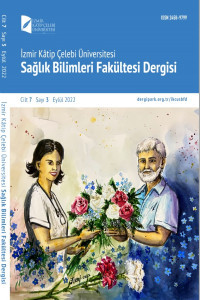Biyoteknolojik Aşıların Geliştirilmesinde Kullanılan Biyoistatistik Analiz Yöntemleri ve Bir Minitab Uygulaması
Biyoistatistik, biyoteknoloji, biyoistatistik teknikler.
Biostatistical Analysis Methods Used in the Development of Biotechnological Vaccines and One Minitab Practise
Biostatistics, biotechnology, biostatistics techniques.,
___
- mikrobiyoloji.org [internet]. Viral Aşılar; 2022 [cited 12 Nisan 2022] Available from: http://www.mikrobiyoloji.org/TR/Genel/BelgeGoster.aspx?F6E10F8892433CFFA79D6F5E6C1B43FF4B5119729FFAA2F9.
- Gebre MS, Brito LA, Tostanoski LH, Edwards DK, Carfi A, Barouch DH. Novel approaches for vaccine development. Cell. 2021 March 18; 184(6): 1589-1603. Available from: https://doi.org/10.1016/j.cell.2021.02.030.
- Meuleman TJ, Cowton VM, Patel AH, Liskamp RMJ. Design and synthesis of hcv-e2 glycoprotein epitope mimics in molecular construction of potential synthetic vaccines. Viruses. 2021; 13(2): 326. Available from: https://doi.org/10.3390/v13020326
- Moyle PM. Biotechnology approaches to produce potent, self-adjuvantting antigen-adjuvantt fusion protein subunit vaccines. Biotechnology Advances. 2017 May-June; 35: 375-389.
- Ho W, Gao M, Li F, Li Z, Zhang XQ, Xu X. Next‐generation vaccines: nanoparticle‐mediated dna and mrna delivery. Advanced Healthcare Materials. 2021 January 18; 10(8): 1-17. Available from: https://doi. org/10.1002/adhm.202001812
- Ho NI, Huis in 't Veld LGM, Raaijmakers TK, Adema GJ. Adjuvants enhancing cross-presentation by dendritic cells: the key to more effective vaccines?. Frontiers in Immunology. 2018 December 13; 9: 1-12.
- Pearson K. Antityphoid inoculation. British Medical Journal. 1904 December 17; 2: 1667–1668.
- Greenwood M, UG Yule. The statistics of anti-typhoid and anti-cholera inoculations, and the interpretation of such statistics in general. Proc R Soc Med, 1915 June 4; 8(part 2): 113–194.
- Kendrick P, Eldering G. A study in active immunization against pertussis. with statistical analyses of the data by aj borowski. American Journal of Hygiene. 1939; 29: 133-53.
- Halloran ME, Longini IM, Struchiner CJ, Longini IM. Design and analysis of vaccine studies. New York: Springer; 2010. 103-129p.
- Adak D, Majumder A, Bairagi N. Mathematical perspective of Covid-19 pandemic: Disease extinction criteria in deterministic and stochastic models. Chaos, Solitons & Fractals. 2020 October 19; 142: 1-11.
- Longini Jr, Ira M. Chain binomial model. Encyclopedia of Biostatistics. Wiley Online Library Encyclopedia of Biostatistics. 2005 July 5. Available from: https://doi.org/10.1002/0470011815.b2a07008
- Kyvsgaard NC, Vang Johansen M, Carabin H. Simulating transmission and control of taenia solium infections using a reed-frost stochastic model. International Journal for Parasitology. 2006 November 24; 37(5): 547-558. Available from: 10.1016/j.ijpara.2006.11.018
- Greenwood M. The statistical study of ınfectious diseases. Journal of the Royal Statistical Society. 1946; 109(2): 85–110.
- Riley MC, Clare M, King RD. Locational distribution of gene functional classes in arabidopsis thaliana. BMC Bioinformatics. 2007 March 30; 8(112): 1-12.
- Ulutürk Akman S. Biyoistatistik [Internet]. İstanbul Üniversitesi Açık ve Uzaktan Eğitim Fakültesi [Cited 15 February 2022]. Available from: http://auzefkitap.istanbul.edu.tr/kitap/kok/biyo istatistik.pdf
- Akpınar H. Bulaşıcı hastalıkların yayılımının tahmininde deterministik modellerin kullanılması. Öneri Dergisi. 2012 Temmuz; 10(38): 97-103.
- By Minitab Inc. Minitab User Guide 2: Data Analysis and Quality Tools Release 13 for Windows, Windows 95, Windows 98, and Windows NT 2000. ISBN 0-925636-44-4; 2000. Chapter 9 (1-13p.)
- uroturk.org.tr [Internet]. [cited 2022 September 10] Available from: https://uroturk.org.tr/ urolojiData/Uploads/files/gelecek-akademisyen-1210/Sunum-9.pdf
- McNulty CAM, Bowen JK, Williams AJ. Hepatitis B vaccination in predialysis chronic renal failure patients a comparison of two vaccination schedules. Vaccine. 2005 July 14; 23(32): 4142-4147.
- Alhindi Y, Albarakati R, Almatrafi L, Fatta G, Fatani B. Report on the Investigating Factors Associated with Vaccine Hesitancy in Makkah [Internet]. KSA [cited 2022 1 April]. 1-8 p. Available from: https://drive. uqu.edu.sa/up/profile/Books/4290019/book_path_SqaGX9FFlr.pdf
- ISSN: 2458-9799
- Yayın Aralığı: Yılda 3 Sayı
- Başlangıç: 2016
- Yayıncı: İzmir Katip Çelebi Üniversitesi
Sağlık Bilimleri Öğrencilerinin Alzheimer Hastalığı ve Demansa Yönelik Bilgi ve Tutumları
Yaşlılarda Tele Hemşirelik Uygulamaları
Burcu AKPINAR SÖYLEMEZ, Ecem ÖZGÜL
Sabriye UÇAN YAMAÇ, Nurten TERKEŞ
Gelişimsel Bakış Açısıyla Spinal Musküler Atrofi’de Çocuğun Sağlık Hakkı ve Yaşam Kalitesi
Senemhan YILMAZ, Bedriye Tuğba KARAASLAN, Gözde AKOĞLU
Çalışma Yaşamında Dezavantajlı Gruplar ve Eşitsizlikler
Kanserli Çocukların Kardeşlerinde Depresyonun Değerlendirilmesi: Bir Pilot Çalışma
İbrahim EKER, Özge VURAL, Hamide Nur ÇEVİK ÖZDEMİR, Elif Bilge KELEBEK, Nihan ÇAKALOĞULLARI, Naci GÜLTEKİN, Özge KAYA, Esma KURAL, Bilge MUMYAKMAZ, Orçun ÖZTÜRK, Nevzat SAKARYA
Sevtap GÜNAY UÇURUM, Damla KARABAY, Hilal UZUNLAR, Derya ÖZER KAYA, Berna EROĞLU FİLİBELİ, Bumin DÜNDAR
